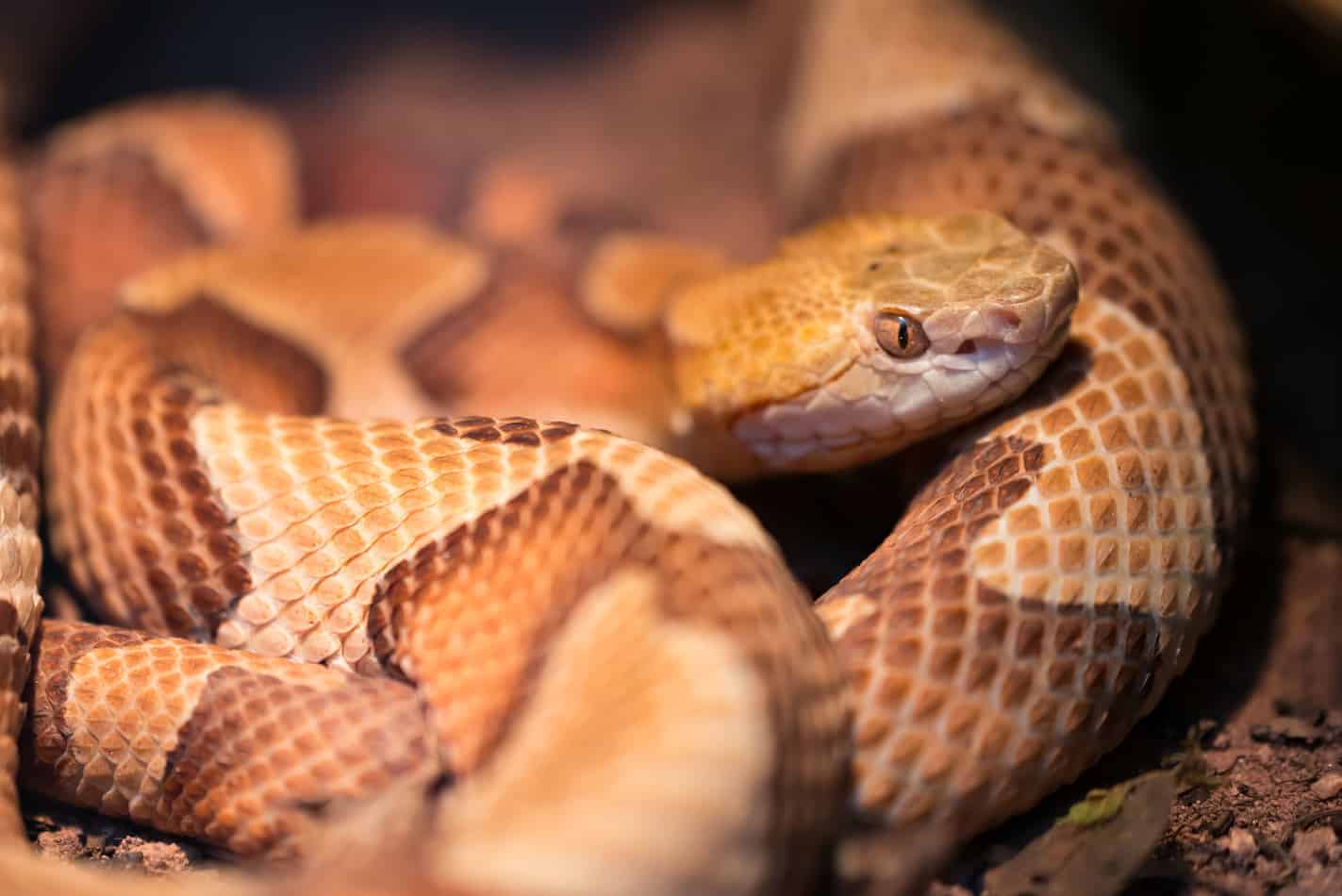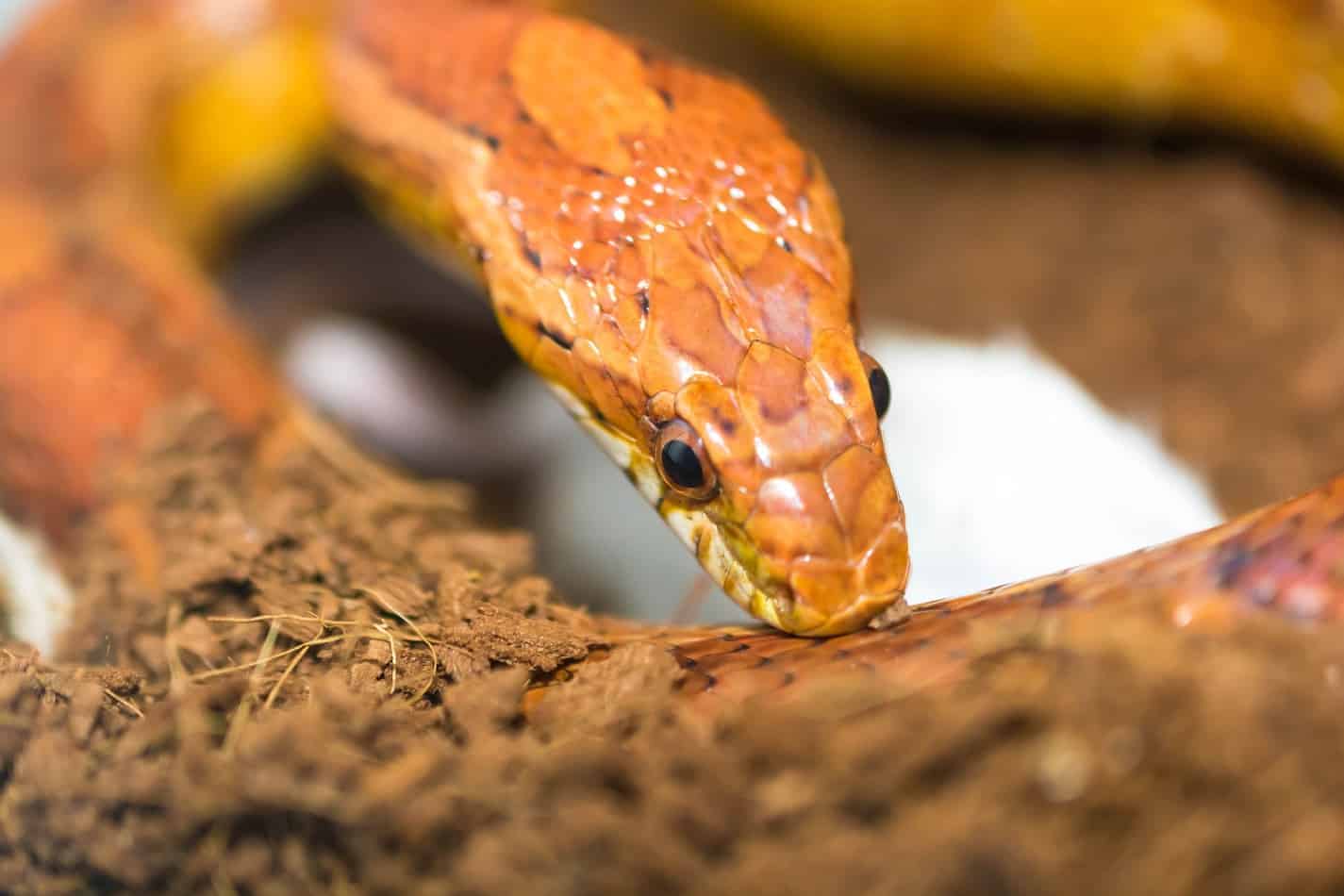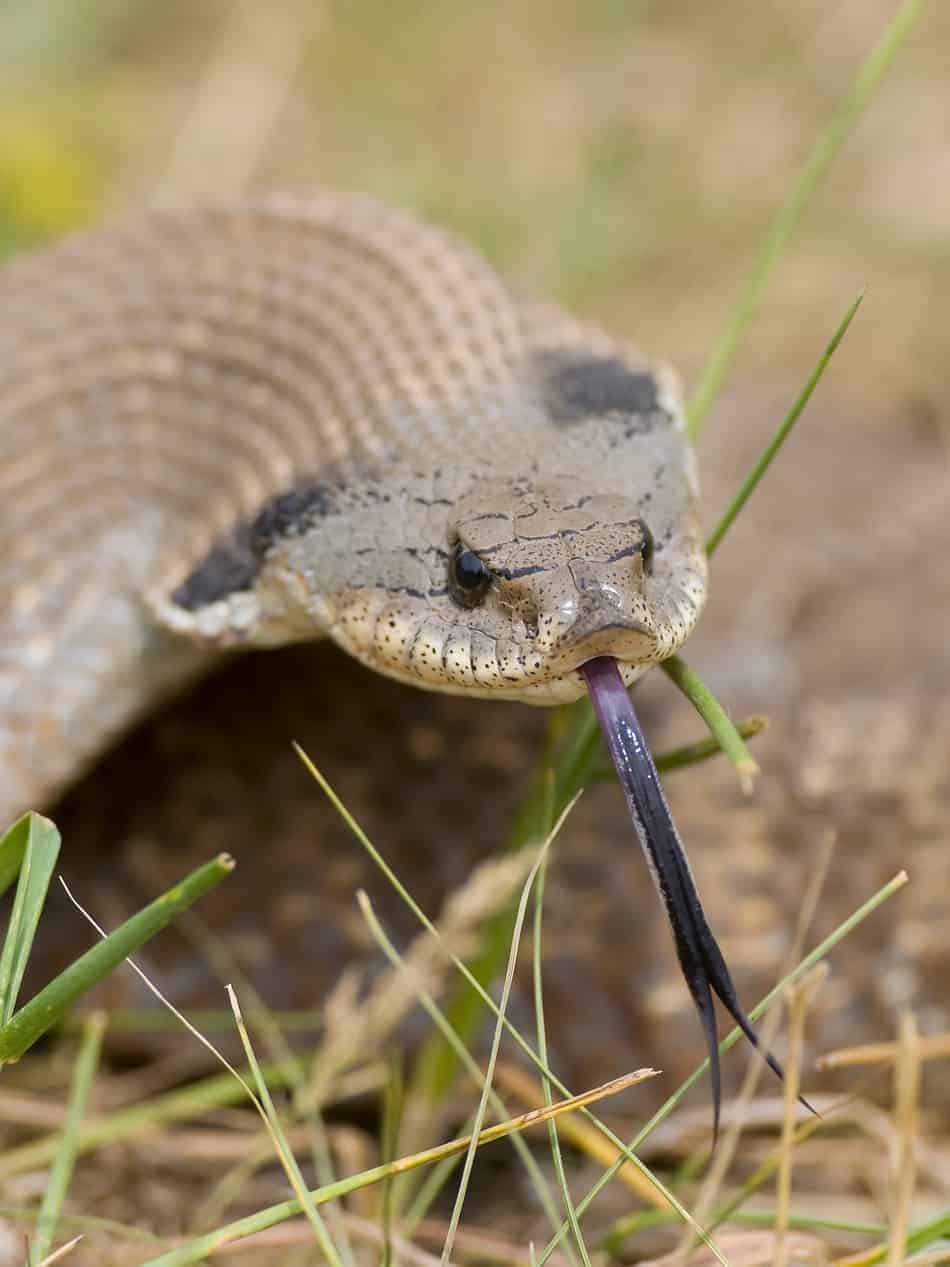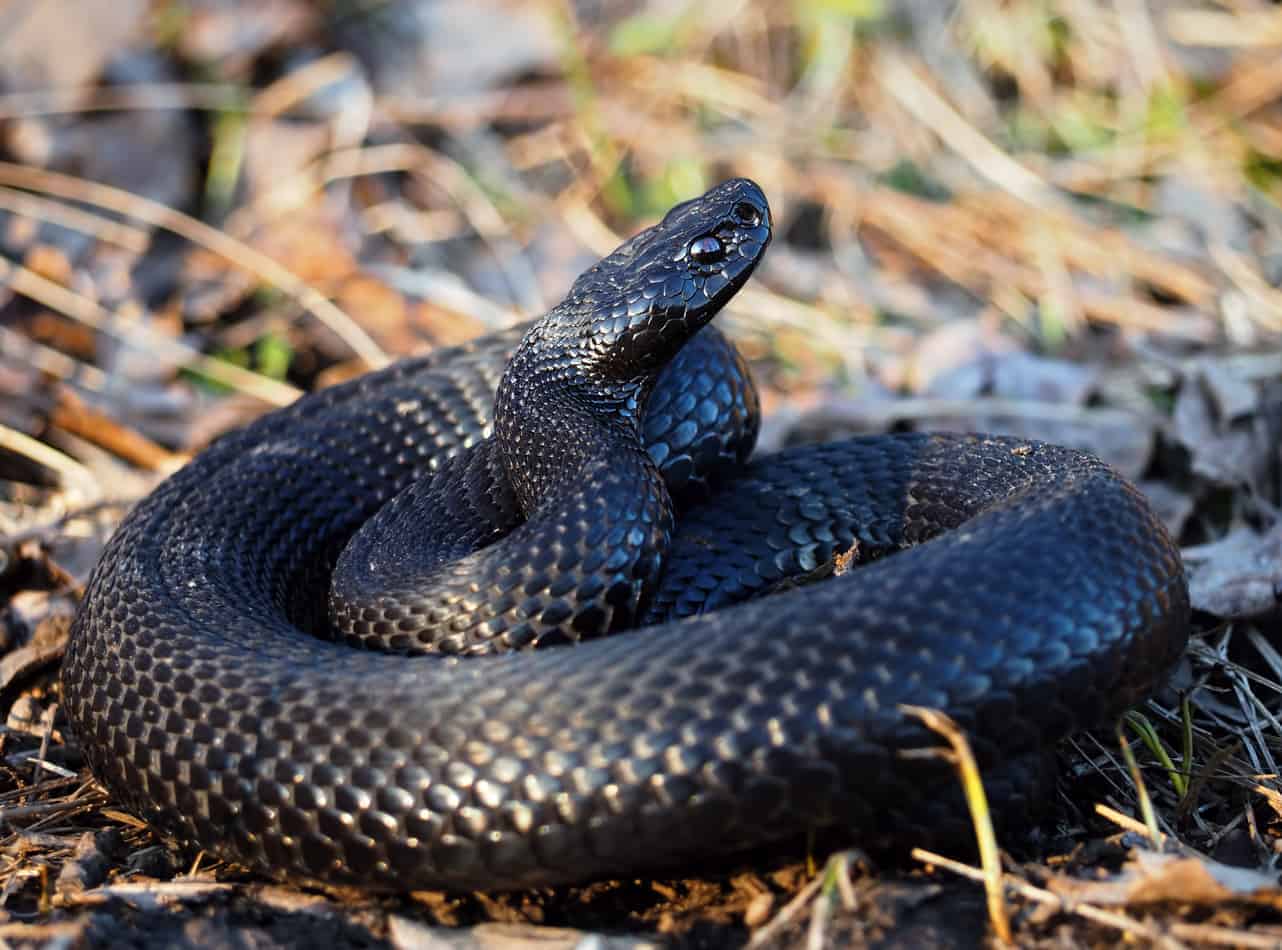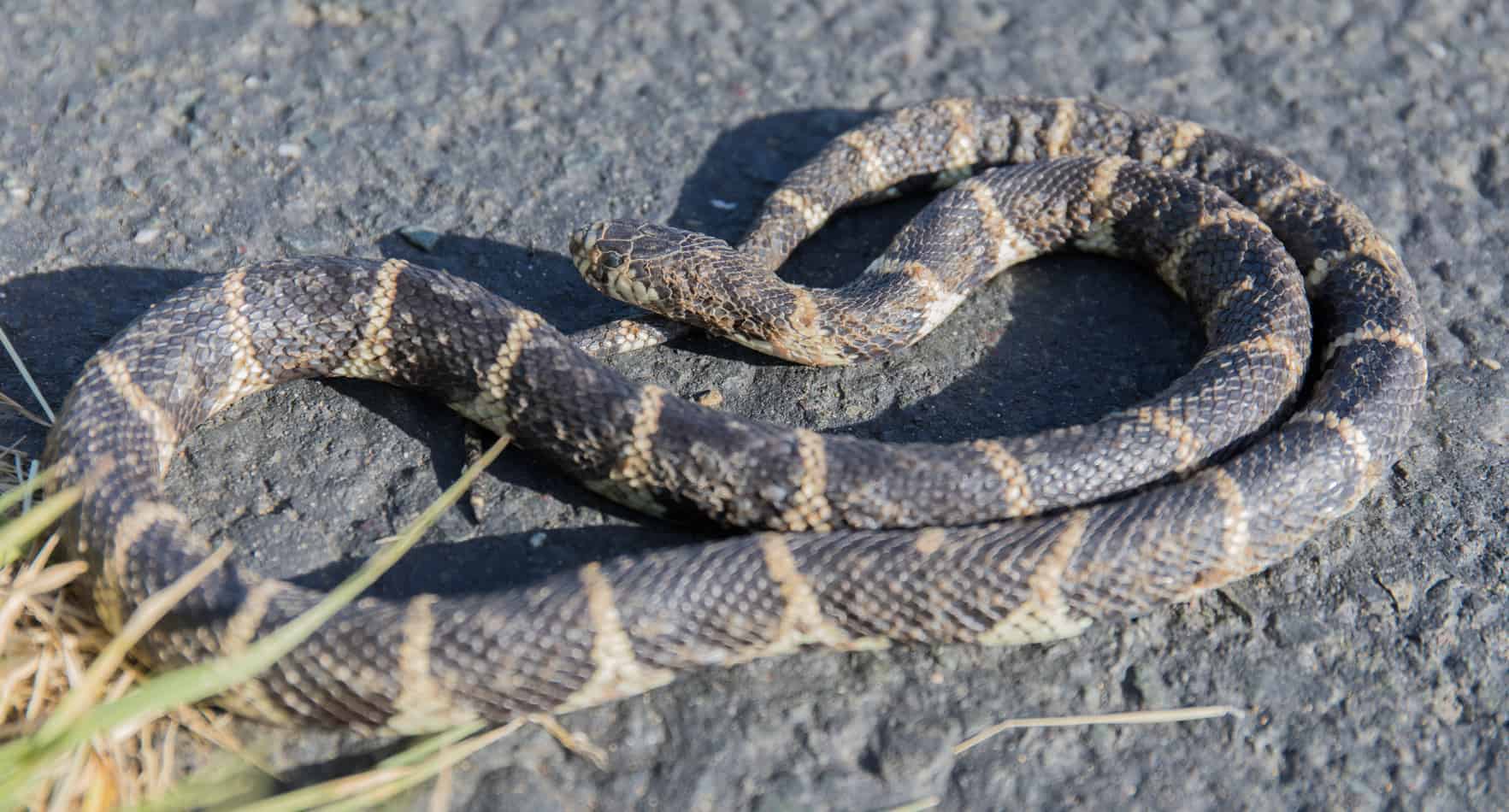These 5 Snakes Look Similar to Copperheads
Copperheads aren’t all that common and are often confused for several other snakes. Here are five more common snakes you’re probably seeing instead.
What Copperheads Do Look Like
We’re going to go over the basic looks, characteristics, and
Copperheads are, unsurprisingly, a coppery color. Sometimes scientists get tired, I think, and just give up on all those fancy names. The ground, or main body color, ranges from a pinkish tan (read: copper) to a pale tan (not much variety, not even in the morphs or subspecies). The belly is usually the same color as the body, though it is sometimes a lighter shade.
They are covered in crossbands. These crossbands only ever span the back of the snake, and never extend all the way down to their ventral (belly) side. They are a pale brown color (typically) in the center, and grow darker around the outside, ending in a black border running the perimeter of the crossband.
Often times, these crossbands will be split right down the middle, and alternated, almost like the laces on your tennis shoes. Most copperheads don’t have even a single full crossband.
The shape of a typical copperhead crossband is reminiscent of an hourglass, or maybe two Hershey’s Kisses touching. The latter image is helpful if you’re food minded, like me.
In between the crossbands, and all along both flanks, near the belly, are dark brown, smallish spots. There are about ten to eighteen crossbands on each copperhead snake, but the number of spots varies from case to case.
The crossbands range in width from two scales wide at the top of the back to as many as six to ten scales wide on the sides of the body. At the base of the tail, there are from one to three- although usually, it’s just two- solid brown crossbands about 2 scales wide. The tip of the tail is gray.
In juvenile copperhead snakes, there are more crossbands at the tail, about seven to nine of them, and the tip of the tale is yellow. This pattern fades as they age. The young snakes use this brightly colored tail to lure lizards, insects, and frogs to join them for dinner. This is called caudal luring, and perfectly toes the line between a nifty skill and a nasty skill.
Most copperheads grow in length to only about three feet. The males are slightly bigger than the males. The body is thick and stout, and the head is distinct from the neck. The snout is less blunt, and consequently, the top of the head actually extends further than the mouth itself.
Basically, from an aerial view, a copperhead snake’s head looks so much like a triangle. Phineas (though perhaps not his brother Ferb) would be crazy jealous.
Copperheads are the color they are because it helps them camouflage almost perfectly into their habitat. Copperhead snakes are endemic to Eastern North America, which means that not only are they native to that area, but they are also exclusive to that area. You won’t find copperhead snakes anywhere else.
They are found in 28 states, nearly covering every letter in the alphabet, from Oklahoma all the way to New York in one direction and Florida in the other direction. Then the habitat extends all the way down to Mexico in Chihuahua and Coahuila.
In all this space, copperhead snakes like to spread out and can be found in quite a wide variety of environments. Mostly, especially in the Northern part of the Americas, they tend to stick to deciduous forests and other mixed woodlands and forests. They like to hang around rocky outcroppings and ledges, as those types of places provide lots of little crevices to hide in.
More to the south, closer to Mexico and the Gulf of Mexico, copperhead snakes will live in coniferous forests. And in the most humid sections, they’ve been known to make their homes in low lying, swampy areas (think Illinois). They like to stay close to a water source.
Copperhead snakes are abnormal when it comes to the subject of other pit vipers (a family to which they belong). Most pit vipers, and really, most snakes in general, turn tail and run–er, slither–away at the first sight of danger.
Can you really blame them? Can you look me in the eye and tell me with positive assurance that you could hold your ground as a sixty-foot tall monster came barreling towards you? I doubt it. Copperheads, however, can do just that. (Their monsters are to scale, of course.)
When threatened, copperheads don’t fight or take flight. They take the third option you never knew existed. They freeze. They don’t move a muscle.
Remember that camouflage thing we mentioned a few paragraphs ago? The colors they sport blend in almost perfectly with the ground common to the places they live. As long as they don’t move, you probably won’t be able to see them at all. Especially if you’re colorblind.
This attitude has pros and cons attached to it. On one hand, if they’re frozen, they can’t exactly lash out and bite you for fear of exposing themselves, can they?
But on the other, since you probably won’t notice them, you have a much higher chance of accidentally stepping over or even right onto them. That being said, copperheads usually only bite in the event of physical contact. And even then, they, more commonly than any other pit viper, will often deliver a “dry bite” that only releases a small amount of venom.
When they hunt, copperhead snakes are more of a “sit and wait” type than a “come and take” type. They like to position themselves in a promising place and sit, stock still, waiting to ambush the next meal that walks by.
They will actively chase down cicadas and caterpillars. Maybe those particular insects are much tastier and worth the effort. I certainly don’t want to take the time to test that out first hand, but if you ever have a solid answer, feel free to get in touch.
Snake Mistake No. 1: Corn Snakes
Now that you know what an actual copperhead looks like, you can start telling the differences between it and whatever other snakes you come across.
The most common mistaken identity is a corn snake. These snakes are reddish-brown or rust colored. This, especially at a distance or in a panic can be easily be mistaken for the more muted, coppery color of a copperhead. Corn snakes, however, are definitely red, so red, in fact, that they got the nickname red rat snake.
Aside from the color, corn snakes do have crossbands, just like copperheads, but their cross-bands are straighter and shaped less like the hourglass shape of the copperhead crossband.
If you can’t see any Hershey’s Kisses shapes, then you’re good. Maybe just remember it like this: Chocolate is a guilty pleasure, so only the guilty (venomous) snakes have them. I don’t know if that helped you, but it certainly helped me. (As I said, I’m food-minded. Give me some Trader Joe’s dark chocolate, and I’ll ignore any snake for as long as it takes me to consume my entire caloric content for the day in one sitting.)
The body of a corn snake is also thinner in general. Really, the color is going to be your best bet for distinguishing between a copperhead snake and a corn snake. Even though corn snakes are typically thinner and have a more angular head, each individual snake is going to be different.
Maybe the copperhead is malnourished and skinnier, or maybe the corn snake just has an unusual triangular head. So I would say just stick to the coloring. And of course, if you’re still not sure after that, just avoid the snake.
Thinking about buying a corn snake? Read this article that we wrote where we list 10 pros and cons of having a corn snake as a pet.
Snake Mistake No. 2: Northern Water Snake
The next most common snake to be confused with a copperhead snake is a northern water snake. Prepare to be enlightened.
One major identification factor: W
Identification number two: the patterns are (once again) different. Remember those Hershey’s Kiss-shaped bands? I’m going to keep coming back to those because:
1) I really do love chocolate more than the average person really ever should and,
2) the copperhead’s distinct pattern is going to be a sure bet in distinguishing them from most other snakes. Water snakes have the opposite of Hershey’s Kiss bands.
While copperhead crossbands are narrow in the middle and wide on the edges, water snake crossbands are wide in the middle and narrow on the edges.
Water snakes differ immensely from location to location, growing to different lengths and sporting different colors. Usually, however, you can count on water snakes having no distinct neck, whereas copperheads do. Besides that, water snakes are darker colored than copperheads, although that too can vary from location to location for the water snakes.
Snake Mistake No. 3: Hognose Snakes
No, I’m not listing the differences between pigs and copperheads, even though I would love to, seeing as that would be the easiest article I would ever write. This isn’t just the stuff of fantasy and legend, there are actually snakes called hognose snakes, mostly due to their upturned snout.
Hognose snakes are so diverse and varied, that if you gathered a bunch of different subspecies and morphs of the hognose in one pen, you would probably think that none of them belonged to the same species.
Even snake experts, or herpetologists as they’re called in their world, have a hard time identifying hognose snakes. This variety is part of what attributes to the hognose snakes’ ability to be confused with a copperhead, a snake that really shouldn’t look anything like a hognose snake.
Another attributing factor is the fact that hognose snakes live in the same places that copperhead snakes do. They all live in the East of North America (hence the name Eastern hognose snake).
With the same habitat come some of the same behaviors and camouflages, making it even more difficult to tell the difference. If both snakes are so common, it is only logical that it would be common to confuse the two.
Their namesake is actually the easiest way to set hognose snakes apart from copperhead snakes. They will try and puff out their necks when threatened, making their head look more triangular.
However, even with this added width, they can never quite make the cut, and you will be able to tell the difference between the truly triangular head of the copperhead snake and the head of a pretending hognose snake. Hognose snakes also glaringly lack the spots along their flanks that copperheads have.
Snake Mistake No. 4: Black Racer Snake
This snake I think has the coolest name in the entire history of naming snakes ever. And yes, I am aware of the bias in that statement. Our next contestant goes by the non de plume of the black racer snake. See, pretty cool, huh? I want a name like that, something intimidating and epic.

Black racer snake
Really, it’s only the babies that get confused with copperheads. When born, baby black racers have a pattern of crossbands that, though lacking the distinctive Hershey’s Kiss shape (see, there I go again), could be confused with a copperhead pattern at first glance.
And let’s be honest, you’re not typically in the mood for a second, closer look at a snake that you think might be poisonous. As black racer snakes grow and mature, their pattern fades and melds into a solid black color that covers their entire body, true to their name.
Funnily enough, this change only makes sure that they are often confused with water moccasin snakes, a completely different venomous snake.
The patterns on juvenile black racer snakes will be thick splotches that only cover their back and do not extend down their flanks like the crossbands on copperheads. Black racers also have a narrow head that is very much unlike the triangular head of a copperhead snake’s head.
Snake Mistake No. 5: Mole King Snakes
I purposely saved the snake carrying the title of King for the end of the list. Can’t let them get too full of themselves, you know?

kingsnake
Much like black racer snakes, mole kingsnakes will start off clearly patterned, and as they age, their patterns will fade, in this case to a uniform brown color. Some kingsnakes, however, do manage to keep their patterns for the long term. Maybe it’s just a matter of sheer willpower, I don’t know.
Color-wise, mole kingsnakes are more of a reddish brown than a rusty brown, which I know is a ridiculous distinction to expect anyone to make. The only people who are really going to know at first glance are archaeologists or other artifact enthusiasts, maybe doctors who treat tetanus, and those people who always get the Autumn catalogs from Urban Outfitters (seriously, my mom can tell the difference between inky black and ebony black, it’s insane, and more than a little impressive).
But, the point still stands, that slight color variation is one of the ways to tell the difference between a snake that will kill you, and a snake that won’t. Good luck!
Okay, I kid, I apologize. There are a few other ways to distinguish the two. On the kingsnakes that do have patterns, their spots are small, oval, uniform, and only cover the back. Copperheads are just about the exact opposite in all those fields.
Kingsnakes also have small black eyes and small narrow heads, while copperheads have large yellow eyes and large triangular heads. With a name like “kingsnake,” you’d expect a kingsnake to be a lot bigger, but really they’re not. They are actually a little smaller than copperhead snakes.
Copperhead Mimicry
At first, I thought it was a little strange that so many snakes could get confused with copperhead snakes. I mean, after all, aren’t species supposed to be different? That’s why they’re split up, isn’t it?
Well, even though the genetics between snakes varies just as much as in humans, there are a few evolutionary tactics at play here. Mimicry, just a very fancy word for being a copycat, is a defensive tactic often employed by nonvenomous animals.
If you want predators to avoid you, all you have to do is look like a dangerous animal that those predators want to avoid. Then you’re home free!
So really, the reason you’re going to get the heebee-jeebees every time you see a snake that looks poisonous is all due to some natural copycat tactics. All you little siblings, take note. You’re going to need to get really good at being a copycat if you’re going to successfully fulfill your role as chief annoyer of the older kids.
Related Questions
Are copperhead snakes dangerous? Copperhead snakes are venomous, and a bite from them needs to be immediately followed by a hospital visit. However, when they do bite, they often “dry bite,” meaning they only expel a small amount of poison.
How often do copperhead snakes bite? Copperhead snakes are unique in that they usually give no warning before they bite, unlike, say, rattlesnakes that rattle before they do. If you just watch where you step when hiking, you’ll be just fine. Copperhead snakes do not actively attack humans.
Are baby copperhead snakes more poisonous? Some people think that baby snakes are more poisonous because they have no control over how much venom they expel. There wasn’t a single thing correct in that entire sentence, except maybe the word “snake.” Adult snakes are just as, if not even more, poisonous as baby snakes.

